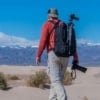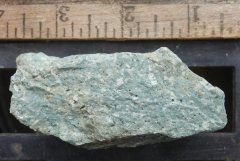Again, nice find, and many thanks for linking the modern geologic map of the two quadrangles. The work of R. B. Morrison published as USGS Professional Paper 401 in 1964 is impressive, and the work of Bell, Caskey, and House linked above expands very nicely on Morrison's.
Their description of the "Ts" stratigraphic unit shows it to be a mixing bowl of sedimentary and volcanic derived sedimentary rocks, generally of rhyolitic composition but including some basaltic flows and tuffs (and the "intermediate" composition guessed by me initially falls between rhyolitic and basaltic.) Notable in their description of the Ts unit is that the unit is locally highly silicified and Liesegang banded. Silicification and Liesegang banding are post depositional processes generally related to hot silica rich fluids being introduced into the permeable sediments (silicification) and poorly understood geochemical process producing concentric banding (Liesegang banding--known as wonderstone). Notably, the text description of Ts mentions formation of resistant peaks and ridges where silicification and alteration of Ts is prevalent, so my guess is that your "green mountain" is one such sllicified zone within the Ts stratigraphic horizon. I would further guess that locating and prospecting mapped exposures of Ts could be good wonderstone finding territory. I don't have the impression that wonderstone is either rare or valuable, but I mention prospecting for samples cautiously because of having a zero percent understanding of the legal and ethical aspects of sample collecting within BLM lands.
Again, nice find!
Foy















